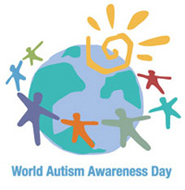
The eighth annual World Autism Awareness Day was Thursday, April 2nd. Autism Spectrum Disorder (ASD) has received increasing national attention because early identification and intervention offers the best prognosis for individuals with ASD. Recently, with the publication of an updated diagnostic code, all types of autism (e.g., Asperger’s Syndrome, Childhood Disintegrative Disorder) are now described by the general term of ASD. ASD describes a complex brain disorder that significantly impacts an individual’s language and social development. Although ASD can affect each person to varying degrees, the underlying deficit is a lack of understanding of oneself as a social being.
Approximately 1 in 68 children are diagnosed with ASD, with boys being four to five times more likely than girls to have ASD. Scientific evidence suggests that ASD is caused by numerous genetic risk factors and environmental influences rather than one “autism gene”. The term “spectrum” in the name captures the fact that every individual with ASD is affected differently; however, there are three main areas of functioning that are impacted—language development, social interaction abilities, and behavioral functioning. Individuals with ASD have difficulties with typical language development such as babbling, speaking, and using gestures to communicate. These language deficits impact social functioning because our primary way of interaction is with verbal communication. Additionally, individuals with ASD have further social difficulties of maintaining eye contact, having interest in people, seeking out social situations, and understanding emotions in themselves and others. Finally, individuals with ASD tend to have very restricted, rigid interests and have repetitive motor movements such as hand flapping or body rocking.
New, emerging research suggests that there may be early signs of ASD in infants as young as four to six months; however, most warning signs are seen when children are between the ages of one and three. The following “red flags” may indicate that a child is at risk for ASD: lack of big smiles by six months, lack of back and forth sharing of smiles or sounds by nine months, no babbling by 12 months, no words by 18 months, no two to three word sentences by 2 years (e.g., “want milk”), no imitation of simple actions (e.g., pat-a-cake) by two to three years, difficulties with pretend play by two to three years, or any loss of speech, babbling, or social skills at any age.










